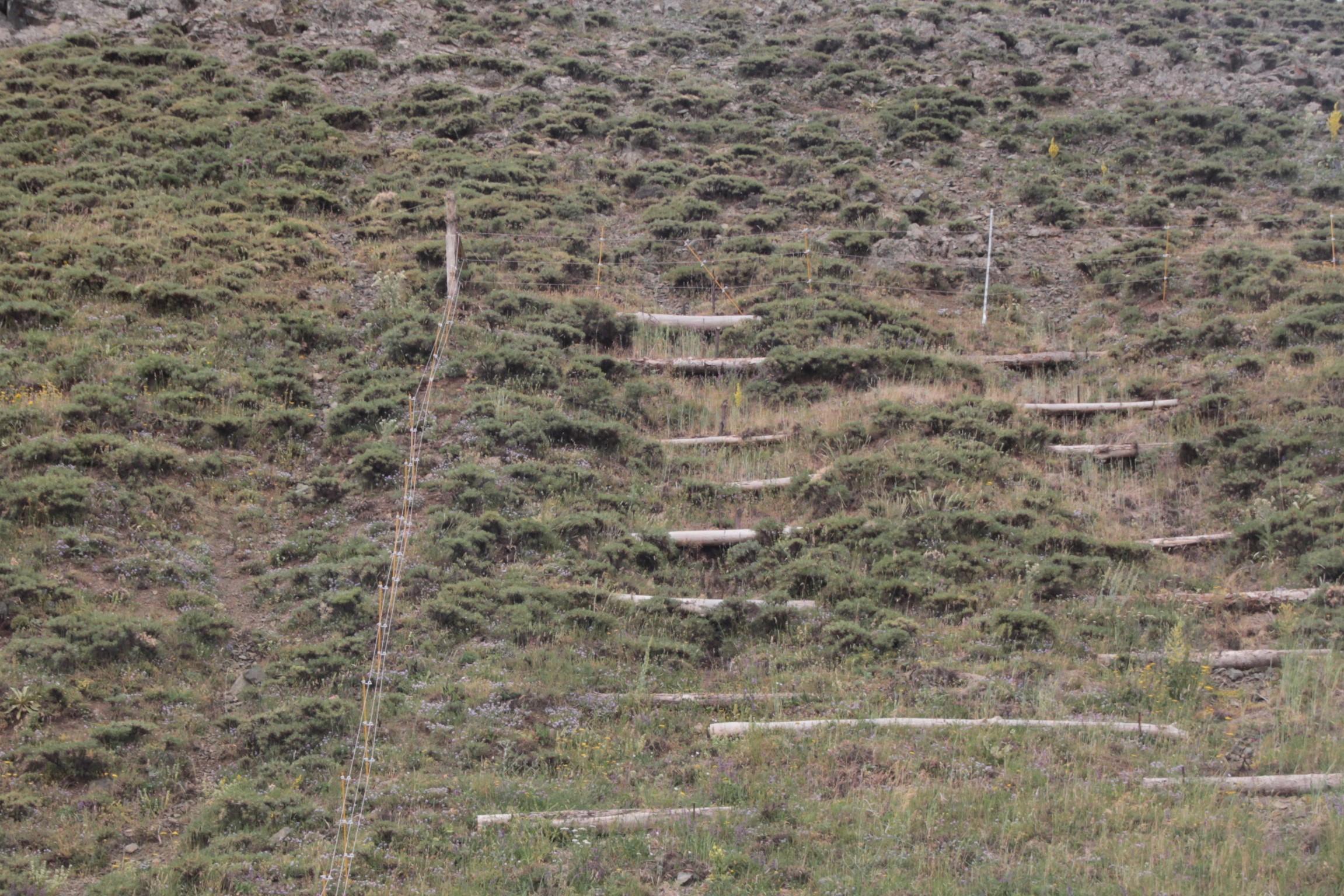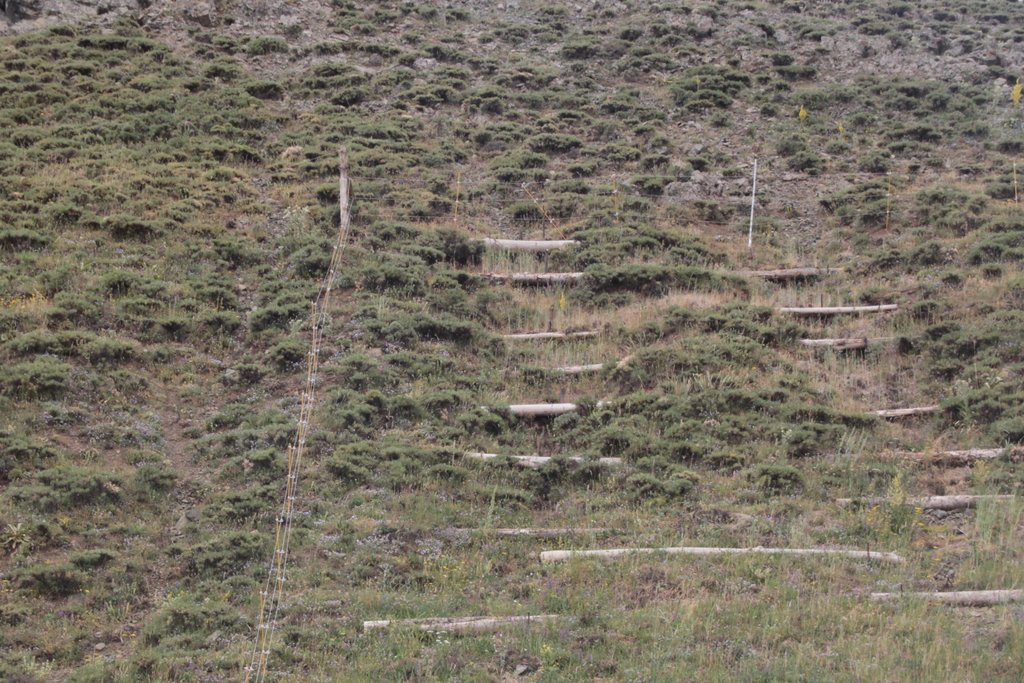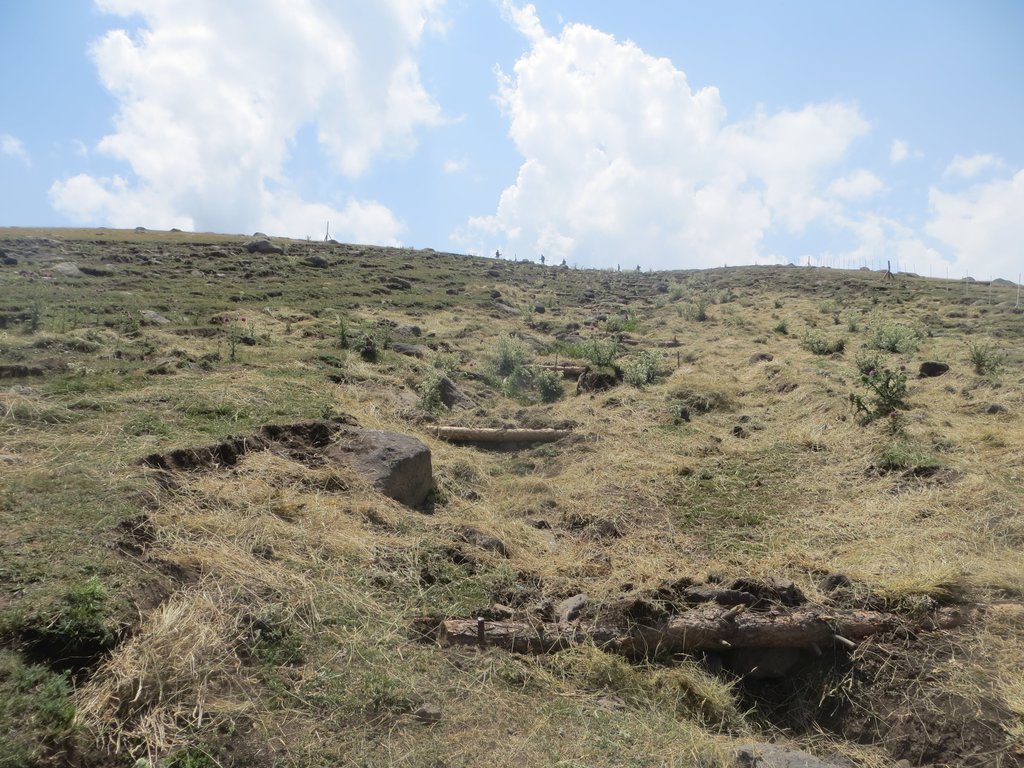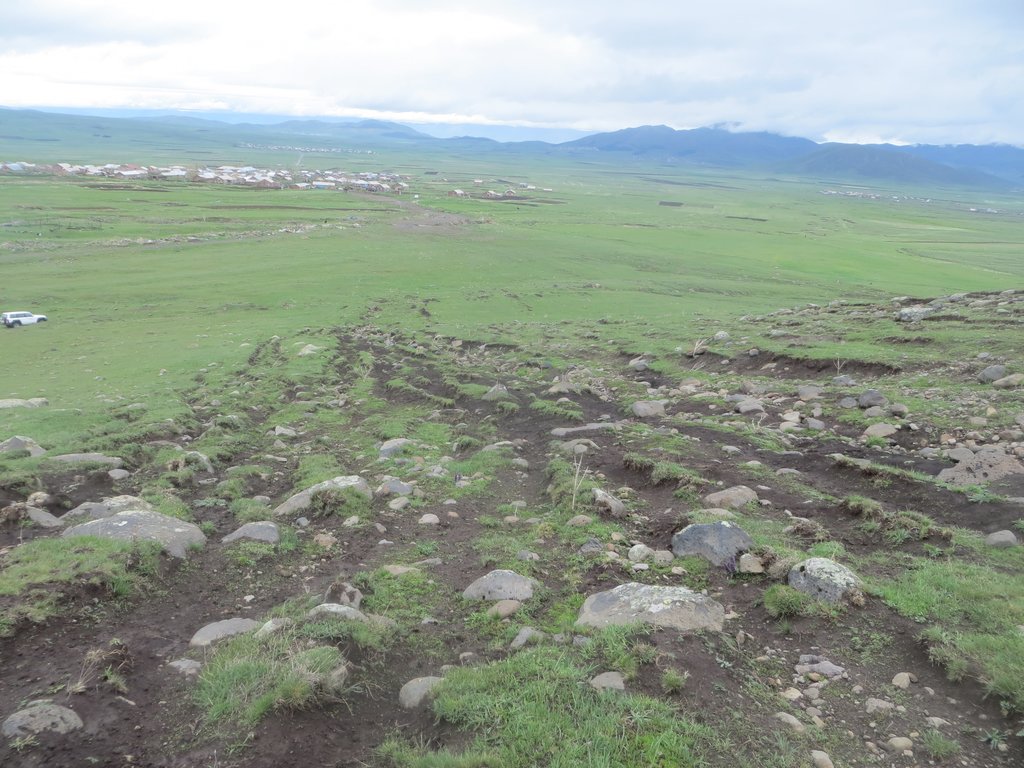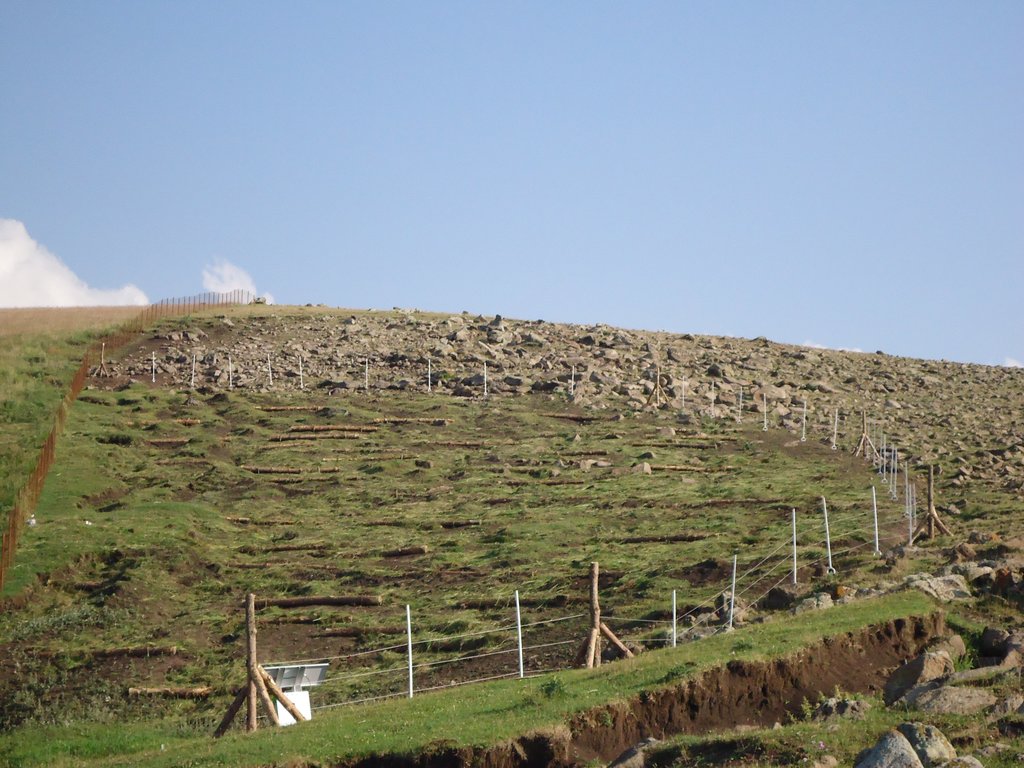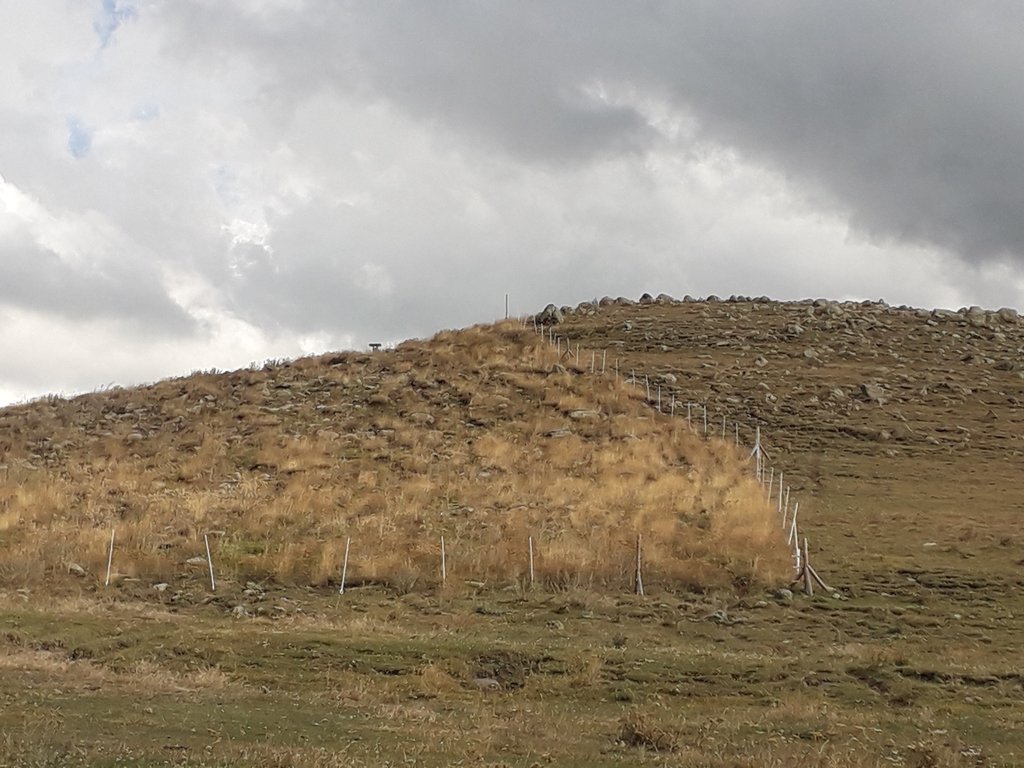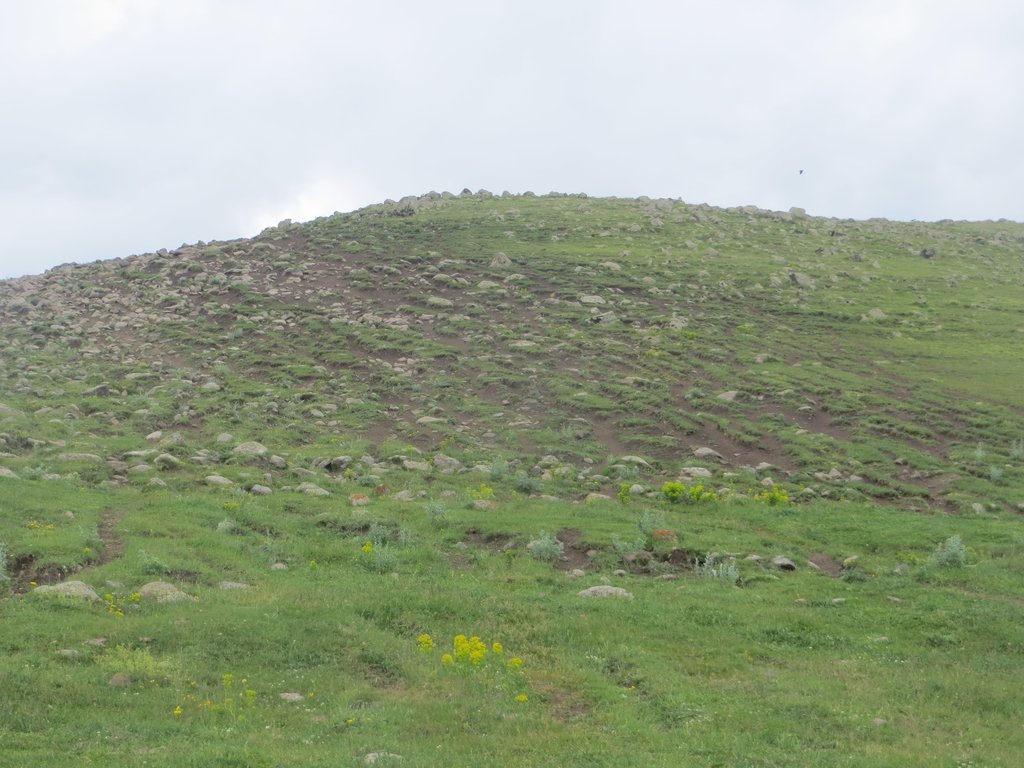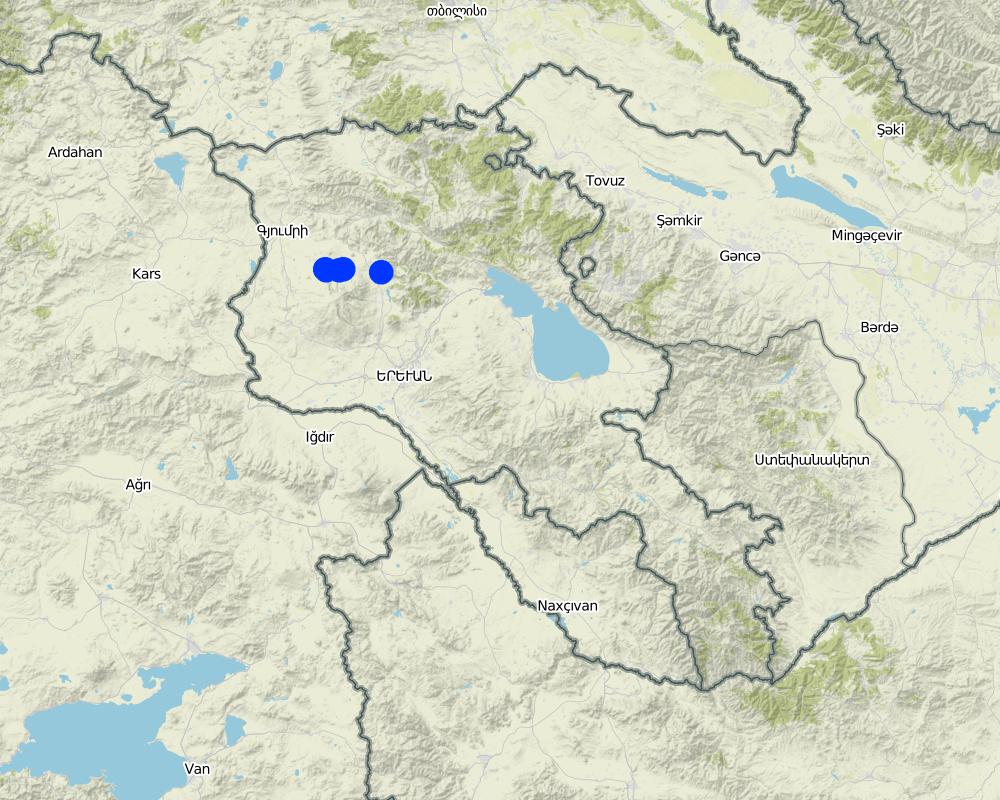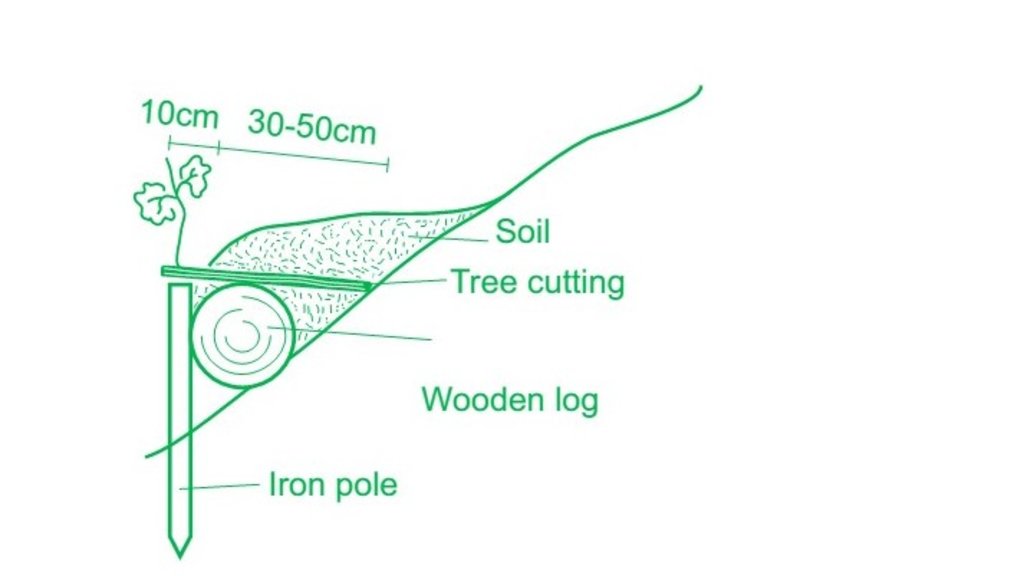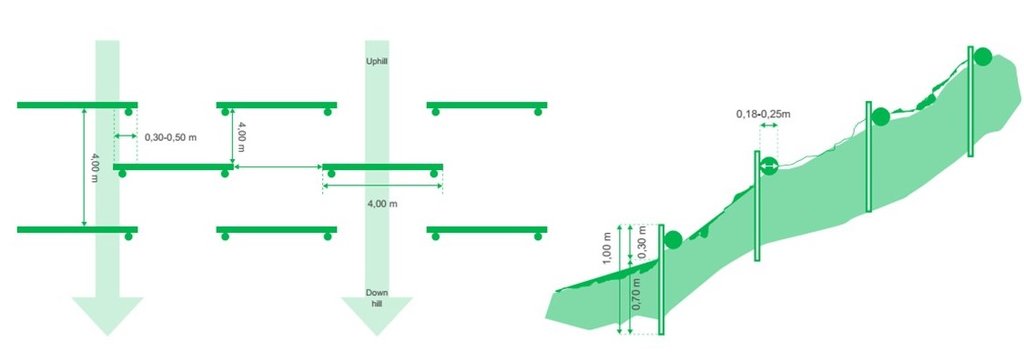Slope erosion control using wooden pile walls [Arménie]
- Création :
- Mise à jour :
- Compilateur : Hanns Kirchmeir
- Rédacteur : Artur Hayrapetyan
- Examinateur : Ursula Gaemperli
technologies_4092 - Arménie
Voir les sections
Développer tout Réduire tout1. Informations générales
1.2 Coordonnées des personnes-ressources et des institutions impliquées dans l'évaluation et la documentation de la Technologie
Personne(s)-ressource(s) clé(s)
Spécialiste GDT:
Mnatsyan Aghasi
+374 (0)96001193
aghasi.mnatsyan@giz.de
GIZ
4/1 Baghramyan Street, 0019 Yerevan, Armenia
Arménie
Spécialiste GDT:
Khachatryan Hrant
+374 94 839083 / +374 91 926092
hkhachatryan84@gmail.com
ESAC NGO, Armenian National Agrarian Univercity
Yerevan, Davit Anhaght 23
Arménie
Spécialiste GDT:
Huber Michael
0043463504144-24
huber@e-c-o.at
E.C.O. Institute of Ecology
Lakeside B07b 9020 Klagenfurt
Autriche
Nom du projet qui a facilité la documentation/ l'évaluation de la Technologie (si pertinent)
Integrated Biodiversity Management, South Caucasus (IBiS)Nom du ou des institutions qui ont facilité la documentation/ l'évaluation de la Technologie (si pertinent)
Deutsche Gesellschaft für Internationale Zusammenarbeit (GIZ)1.3 Conditions relatives à l'utilisation par WOCAT des données documentées
Quand les données ont-elles été compilées (sur le terrain)?
03/10/2018
Le compilateur et la(les) personne(s) ressource(s) acceptent les conditions relatives à l'utilisation par WOCAT des données documentées:
Oui
1.4 Déclaration sur la durabilité de la Technologie décrite
Est-ce que la Technologie décrite ici pose problème par rapport à la dégradation des terres, de telle sorte qu'elle ne peut pas être déclarée comme étant une technologie de gestion durable des terres?
Non
1.5 Référence au(x) questionnaire(s) sur les Approches de GDT
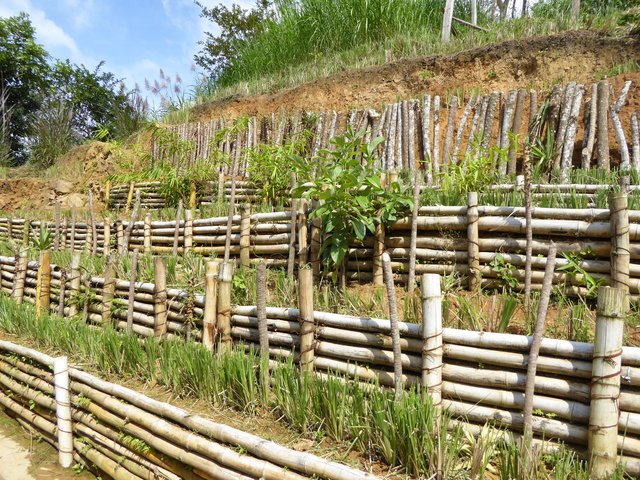
Estabilización de laderas de manera participativa [Honduras]
La bioingeniería comprende una serie de técnicas que utilizan materiales vegetativos vivos para prevenir la erosión y el deslizamiento de laderas y taludes. Las obras de bioingeniería se aplican a base de un análisis integrado de riesgo, son de multi-uso en su conjunto, tienen un bajo costo de construcción y …
- Compilateur : Helen Gambon
2. Description de la Technologie de GDT
2.1 Courte description de la Technologie
Définition de la Technologie:
Small horizontal wooden structures and terraces on eroded slopes built to mitigate sheet or rill erosion and slow down water run-off. The technology is easy to apply and efficient to mitigate erosion processes of the upper soil layer and to stop small rock falls.
2.2 Description détaillée de la Technologie
Description:
In the provinces of Aragatsotn and Shirak in Armenia, the weather is cold and temperate with dry summer. Steep slopes, pastures and some autochthonous oak forests make up the area. Farmers make most of their income with grazing by manual labour. The carrying capacity of pastures in the vicinity is regularly exceeded, and they degrade more and more. In order to stabilize the steep eroded slopes, pile walls were established. Pile walls are horizontal constructions along a slope, functioning as erosion control measures by slowing down the superficial water runoff, retaining materials and supporting the rehabilitation of vegetation.
The major advantages are: It is not expensive since mostly locally available materials can be used, and a positive effect can already be observed within a year. Also, the pile walls can be established relatively easy without any need of heavy machinery or specific knowledge and, therefore, allow the involvement of the local population.
In the case of the implementation in Armenia, the exact location for the pilot measures was selected in such a way that grazing activities were almost not impaired. For temporary exclusion of livestock, electric fencing was used. Within the fenced area, pile walls were established in the washed-out rills along the slope to address the water erosion phenomena.
The technical requirements and workload for the construction of a pile wall are relatively low. The needed resources require iron piles, a hammer, wooden logs (or a bundle of branches) and tree cuttings. First, the wooden logs were cut in 1-2 m length to fit into the irregular rills of the slope. After identifying the locations of individual pile walls, the team fixed the logs with iron poles of about 70-100cm length. The distance between the pile walls varies between 1-3m, depending on the topography: the steeper the slope, the closer the distance. The space behind the logs was filled with soil, plant material and rocks to stabilize the construction and to reduce the risk of water washing out the soil and passing below the logs. As a last step, the terraces were covered with hay to provide protection against precipitation and to accelerate re-growth of grass through the seeds contained in the hay residuals.
Community members were surprised how easy and quick the pile walls could be established. A team of two workers established a pile wall within 30 min. Since these areas are usually intensively used and thus are of high importance for the community, even a temporary exclusion from use must be thoroughly discussed and agreed upon.
The measure slows down vertical water-run off and provides steps for cattle. Due to temporary fencing and the application of hay mulch vegetation is recovering on these parts.
2.3 Photos de la Technologie
2.4 Vidéos de la Technologie
Commentaire, brève description:
https://www.youtube.com/watch?v=Apt2D9i18a0
ESAC Project Video
Date:
27/03/2018
Lieu:
Argatsotn/Shirak Marz
Nom du vidéaste:
ESAC
2.5 Pays/ région/ lieux où la Technologie a été appliquée et qui sont couverts par cette évaluation
Pays:
Arménie
Région/ Etat/ Province:
Aragatsotn and Shirak Marzes (Provinces)
Autres spécifications du lieu:
Lusagyugyh, Hnaberd, Ghegadhzor, Saralandj, Mets Mantash
Map
×2.6 Date de mise en œuvre de la Technologie
Si l'année précise est inconnue, indiquez la date approximative: :
- il y a moins de 10 ans (récemment)
2.7 Introduction de la Technologie
Spécifiez comment la Technologie a été introduite: :
- par le biais de projets/ d'interventions extérieures
3. Classification de la Technologie de GDT
3.1 Principal(aux) objectif(s) de la Technologie
- améliorer la production
- réduire, prévenir, restaurer les terres dégradées
- conserver/ améliorer la biodiversité
- réduire les risques de catastrophes
3.2 Type(s) actuel(s) d'utilisation des terres, là où la Technologie est appliquée

Pâturages
Pâturage extensif:
- Semi-nomadisme/ pastoralisme
Principales espèces animales et principaux produits:
cattle (and sheep)
3.3 Informations complémentaires sur l'utilisation des terres
Approvisionnement en eau des terres sur lesquelles est appliquée la Technologie:
- mixte: pluvial-irrigué
Nombre de période de croissance par an: :
- 1
Densité d'élevage/ chargement (si pertinent):
0.89-1.30 pasture load/ha
3.4 Groupe de GDT auquel appartient la Technologie
- pastoralisme et gestion des pâturages
- Amélioration de la couverture végétale/ du sol
- perturbation minimale du sol
3.5 Diffusion de la Technologie
Spécifiez la diffusion de la Technologie:
- répartie uniformément sur une zone
Si la Technologie est uniformément répartie sur une zone, indiquez la superficie couverte approximative:
- < 0,1 km2 (10 ha)
3.6 Mesures de GDT constituant la Technologie

pratiques végétales
- V1: Couverture d’arbres et d’arbustes
- V2: Herbes et plantes herbacées pérennes

structures physiques
- S1: Terrasses
3.7 Principaux types de dégradation des terres traités par la Technologie

érosion hydrique des sols
- Wt: perte de la couche superficielle des sols (couche arable)/ érosion de surface
- Wg: ravinement/ érosion en ravines
- Wm: mouvements de masse/ glissements de terrain

érosion éolienne des sols
- Et: perte de la couche superficielle des sols (couche arable)

dégradation physique des sols
- Pc: compaction

dégradation biologique
- Bc: réduction de la couverture végétale
3.8 Prévention, réduction de la dégradation ou réhabilitation des terres dégradées
Spécifiez l'objectif de la Technologie au regard de la dégradation des terres:
- réduire la dégradation des terres
- restaurer/ réhabiliter des terres sévèrement dégradées
4. Spécifications techniques, activités, intrants et coûts de mise en œuvre
4.1 Dessin technique de la Technologie
4.2 Spécification/ explications techniques du dessin technique
Required materials for 1 pile wall:
- 2 iron poles (0.7-1m) and a hammer
- 1 wooden log (ca. 4 m, 20-25cm diameter)
- 10-20 shrub cuttings (e.g. Salix species)
Selection of appropriate sites for pile walls (where and how to put them):
The logs are being spread on the slope as indictated in the scheme of the figure. The steeper the slope the narrower the vertical spacing in between (max. 4m, min. 1-2 m). On uneven slopes, place the along the depressions as these are the areas where water-run off is strongest. Parts which show no erosion signs can be left out to not destroy existing vegetation cover. The location of the pile walls is determined by the slope and serves to stabilize the slope at superficial level (10-30 cm). It landslides occur that involve deeper soil layers, this technology is not efficient.
Building process:
After placing the logs, those are fixed with two irons at the end (alternatively wooden posts can be used as well). After fixing the logs, the space behind needs to be filled (slight terracing of the slope). Additionally, either shrub seedlings or living cuttings from species such as willows (ca. 50cm long, 2-5cm diameter) should be integrated. Finally, the open soil should be covered by a layer of 2-5 cm of hay/grass containing seeds and eventually additional seeds (from local species) to promote the re-establishment of vegetation. This has also the benefit that this cover keep humidity in the soil, which is particularly important in (semi-)arid areas.
Species used/density:
At least 20 cuttings per pile wall should be planted. Depending on the survival rates, it can be also more. Shrubs additionally stabilize the slope and are to some extent protected by the pile wall.
4.3 Informations générales sur le calcul des intrants et des coûts
Spécifiez la manière dont les coûts et les intrants ont été calculés:
- par superficie de la Technologie
Indiquez la taille et l'unité de surface:
0.15 ha
Indiquez la monnaie utilisée pour le calcul des coûts:
- dollars US
Indiquez le coût salarial moyen de la main d'œuvre par jour:
ca. 20 USD per worker and day (unskilled local workers), 120 USD per day (local expert)
4.4 Activités de mise en place/ d'établissement
| Activité | Type de mesures | Calendrier | |
|---|---|---|---|
| 1. | Selection of eroded sites and size | Modes de gestion | anytime |
| 2. | Clarification of land user rights | Modes de gestion | anytime |
| 3. | Calculate amount of logs and irons needed | Modes de gestion | anytime |
| 4. | Materials check: Local materials and procurement of other materials | Modes de gestion | anytime |
| 5. | Place logs on the eroded slope (favor depressions where water flows are) | Structurel | anytime (best in spring and autumn) |
| 6. | Fix logs with two iron poles at both sides of the log | Structurel | anytime (best in spring and autumn) |
| 7. | Fill the space behind the log with soil, rocks and (willow) cuttings | Structurel | early spring or late autumn (willow cuttings without leaves) |
| 8. | Flatten the area behind the log (small terracing) | Structurel | anytime (best in spring and autumn) |
| 9. | Use additional hay/grass mulch to cover open soil and add additional seeds | Végétale | best in spring (alternatively in late autumn) |
| 10. | If it is grazing area: Fence the area for at least 2-3 vegetation periods | Modes de gestion | during grazing period |
4.5 Coûts et intrants nécessaires à la mise en place
| Spécifiez les intrants | Unité | Quantité | Coûts par unité | Coût total par intrant | % du coût supporté par les exploitants des terres | |
|---|---|---|---|---|---|---|
| Main d'œuvre | Unskilled worker: Implementation of field measures | person days | 30,0 | 21,0 | 630,0 | 10,0 |
| Main d'œuvre | Skilled expert (Implementation supervision and project management | person days | 14,0 | 120,0 | 1680,0 | |
| Main d'œuvre | Transportation costs (truck, experts) | rental days | 12,0 | 54,0 | 648,0 | 10,0 |
| Main d'œuvre | Administration costs | month | 1,0 | 127,0 | 127,0 | |
| Equipements | Consumables | set | 1,0 | 59,0 | 59,0 | 10,0 |
| Equipements | Electric tools | set | 1,0 | 424,0 | 424,0 | 10,0 |
| Equipements | P3800 Fence energizer + Box and equipment | set | 1,0 | 345,0 | 345,0 | |
| Equipements | Solar Panel for fence energizer | piece | 1,0 | 233,0 | 233,0 | |
| Equipements | Battery and fence tester | piece | 1,0 | 203,0 | 203,0 | |
| Matériel végétal | Cuttings (20 per pile wall) (not used as it is being grazed) | pieces | ||||
| Matériel végétal | Hay/grass for mulch cover (Bales ca.20kg) | kg | 800,0 | 0,08 | 64,0 | |
| Matériaux de construction | Wooden logs (3m, 20cm diameter) | pieces | 50,0 | 17,0 | 850,0 | |
| Matériaux de construction | Iron poles (0.7-1m, 10 mm diameter) | pieces | 150,0 | 2,1 | 315,0 | |
| Matériaux de construction | Electric Fence Polywire | m | 1300,0 | 0,3 | 390,0 | |
| Matériaux de construction | Electric Fence Corner donut insulator | pieces | 27,0 | 1,0 | 27,0 | |
| Matériaux de construction | Earth stakes | pieces | 3,0 | 22,0 | 66,0 | |
| Matériaux de construction | Electric Fence Spring Gate Set | piece | 1,0 | 42,0 | 42,0 | |
| Matériaux de construction | Wooden Posts | pieces | 9,0 | 6,4 | 57,6 | 20,0 |
| Coût total de mise en place de la Technologie | 6160,6 | |||||
Si le coût n'est pas pris en charge à 100% par l'exploitant des terres, indiquez qui a financé le coût restant:
GIZ Project
Commentaires:
Initial costs were comparatively high as it is a pilot project. Thus, staff costs and the procurement of electric fence equipment made costs rather high. If materials can be obtained locally costs go down as far as 23 USD/pile wall (including material and work).
4.6 Activités d'entretien/ récurrentes
| Activité | Type de mesures | Calendrier/ fréquence | |
|---|---|---|---|
| 1. | Regular check of fence | Structurel | Once per two weeks |
| 2. | Installation and deinstallation of electric fence | Structurel | Once per year |
| 3. | Changing the broken posts | Structurel | once per year |
| 4. | Optional refill of stones and/or soil if washed out | Structurel | twice per year |
Commentaires:
Almost all maintenance activity refer to the maintenance of the electric fence (which is being removed in winter) and needs to be re-established during the grazing period. The pile wall itself does not need maintenance measures.
4.7 Coûts et intrants nécessaires aux activités d'entretien/ récurrentes (par an)
| Spécifiez les intrants | Unité | Quantité | Coûts par unité | Coût total par intrant | % du coût supporté par les exploitants des terres | |
|---|---|---|---|---|---|---|
| Main d'œuvre | Regular check of fence | workdays | 8,0 | 21,0 | 168,0 | 100,0 |
| Main d'œuvre | Installation and deinstallation of electric fence | workdays | 8,0 | 21,0 | 168,0 | 100,0 |
| Main d'œuvre | Changing the broken posts | workdays | 1,0 | 21,0 | 21,0 | 100,0 |
| Main d'œuvre | Optional refill of stones and/or soil if washed out | workdays | 3,0 | 21,0 | 63,0 | 100,0 |
| Coût total d'entretien de la Technologie | 420,0 | |||||
4.8 Facteurs les plus importants affectant les coûts
Décrivez les facteurs les plus importants affectant les coûts :
Grazing (if fencing is needed it is the most costly part)
Wooden logs (if bought). This can be turned to zero by either using local wood (if permitted) or bundles of branches of specific species (e.g. willows).
5. Environnement naturel et humain
5.1 Climat
Précipitations annuelles
- < 250 mm
- 251-500 mm
- 501-750 mm
- 751-1000 mm
- 1001-1500 mm
- 1501-2000 mm
- 2001-3000 mm
- 3001-4000 mm
- > 4000 mm
Spécifiez la pluviométrie moyenne annuelle (si connue), en mm:
521,00
Spécifications/ commentaires sur les précipitations:
In Aparan, the climate is cold and temperate. Aparan has a significant amount of rainfall during the year. This is true even for the driest month. Precipitation peaks are in May and June.
Indiquez le nom de la station météorologique de référence considérée:
Aparan, Aragatsotn Marz, Armenia
Zone agro-climatique
- semi-aride
According to Köppen and Geiger, the climate is classified as Dfb (Cold/continental, no dry season, warm summers). Annual mean temperature is 5.2. °C. The warmest month of the year is August, with an average temperature of 16.4 °C. January has the lowest average temperature of the year with -6.9 °C.
5.2 Topographie
Pentes moyennes:
- plat (0-2 %)
- faible (3-5%)
- modéré (6-10%)
- onduleux (11-15%)
- vallonné (16-30%)
- raide (31-60%)
- très raide (>60%)
Reliefs:
- plateaux/ plaines
- crêtes
- flancs/ pentes de montagne
- flancs/ pentes de colline
- piémonts/ glacis (bas de pente)
- fonds de vallée/bas-fonds
Zones altitudinales:
- 0-100 m
- 101-500 m
- 501-1000 m
- 1001-1500 m
- 1501-2000 m
- 2001-2500 m
- 2501-3000 m
- 3001-4000 m
- > 4000 m
Indiquez si la Technologie est spécifiquement appliquée dans des:
- non pertinent
Commentaires et précisions supplémentaires sur la topographie:
The technology is applicable on hills and steep slopes with an inclination between 10° and 30 (40)°
5.3 Sols
Profondeur moyenne du sol:
- très superficiel (0-20 cm)
- superficiel (21-50 cm)
- modérément profond (51-80 cm)
- profond (81-120 cm)
- très profond (>120 cm)
Texture du sol (de la couche arable):
- moyen (limoneux)
Texture du sol (> 20 cm sous la surface):
- fin/ lourd (argile)
Matière organique de la couche arable:
- moyen (1-3%)
5.4 Disponibilité et qualité de l'eau
Profondeur estimée de l’eau dans le sol:
5-50 m
Disponibilité de l’eau de surface:
moyenne
Qualité de l’eau (non traitée):
eau potable
La salinité de l'eau est-elle un problème? :
Non
La zone est-elle inondée?
Oui
Régularité:
épisodiquement
Commentaires et précisions supplémentaires sur la qualité et la quantité d'eau:
There are substantial amounts of water (seasonally) from water from melted snow of Aragats mountain
5.5 Biodiversité
Diversité des espèces:
- moyenne
Diversité des habitats:
- faible
Commentaires et précisions supplémentaires sur la biodiversité:
The area is widely used as pasture and shows some degradation signs (e.g. inpalatable plants spreading, open soil, decreasing number of plant species, spreading of Astragalus). On some slopes, autochtonous oak forests (Quercus macranthera) still exist. The area consists of typical sub-alpine to alpine grasslands with medium species diversity.
5.6 Caractéristiques des exploitants des terres appliquant la Technologie
Sédentaire ou nomade:
- Sédentaire
Orientation du système de production:
- mixte (de subsistance/ commercial)
Revenus hors exploitation:
- 10-50% de tous les revenus
Niveau relatif de richesse:
- pauvre
- moyen
Individus ou groupes:
- groupe/ communauté
Niveau de mécanisation:
- travail manuel
Genre:
- femmes
- hommes
Age des exploitants des terres:
- jeunes
- personnes d'âge moyen
Indiquez toute autre caractéristique pertinente des exploitants des terres:
The land owners are the communities in the target region on behalf of community mayors.
5.7 Superficie moyenne des terres détenues ou louées par les exploitants appliquant la Technologie
- < 0,5 ha
- 0,5-1 ha
- 1-2 ha
- 2-5 ha
- 5-15 ha
- 15-50 ha
- 50-100 ha
- 100-500 ha
- 500-1 000 ha
- 1 000-10 000 ha
- > 10 000 ha
Cette superficie est-elle considérée comme de petite, moyenne ou grande dimension (en se référant au contexte local)?
- petite dimension
5.8 Propriété foncière, droits d’utilisation des terres et de l'eau
Propriété foncière:
- état
- communauté/ village
Droits d’utilisation des terres:
- accès libre (non organisé)
- loué
Droits d’utilisation de l’eau:
- accès libre (non organisé)
5.9 Accès aux services et aux infrastructures
santé:
- pauvre
- modéré
- bonne
éducation:
- pauvre
- modéré
- bonne
assistance technique:
- pauvre
- modéré
- bonne
emploi (par ex. hors exploitation):
- pauvre
- modéré
- bonne
marchés:
- pauvre
- modéré
- bonne
énergie:
- pauvre
- modéré
- bonne
routes et transports:
- pauvre
- modéré
- bonne
eau potable et assainissement:
- pauvre
- modéré
- bonne
services financiers:
- pauvre
- modéré
- bonne
6. Impacts et conclusions
6.1 Impacts sur site que la Technologie a montrés
Impacts socio-économiques
Production
qualité des fourrages
Commentaires/ spécifiez:
The erosion control masures stopped top soil Erosion and Gully Erosion in the pasture land.
Revenus et coûts
charge de travail
Commentaires/ spécifiez:
The workload for implementing the measures does not pay off within the first view years but is a long term investment in saving soil productivity.
Impacts socioculturels
connaissances sur la GDT/ dégradation des terres
Commentaires/ spécifiez:
The intervention raised awareness to soil erosion and new technologies have been trained to village stakeholders (pile walls, electric fencing)
Impacts écologiques
Cycle de l'eau/ ruissellement
quantité d'eau
Commentaires/ spécifiez:
Water run off is decreased and soil moister is increase by better infiltration of water into the soil.
évaporation
Commentaires/ spécifiez:
The increase of vegetation leads to an increase of evaporation-transpiration.
Sols
humidité du sol
Commentaires/ spécifiez:
Water run off is decreased by pile walls and better vegetation cover and soil moister is increase by better infiltration of water into the soil.
perte en sol
Commentaires/ spécifiez:
Decrease of water run off by pile walls and increased vegetation cover leads to decrease of soil loss.
matière organique du sol/ au dessous du sol C
Commentaires/ spécifiez:
Increase of vegetation leads to more root activity and humus increase by increase of litter.
Biodiversité: végétale, animale
Couverture végétale
Commentaires/ spécifiez:
The stop of grazing and trampling by the fence leads to fast increase of vegetation cover.
biomasse/ au dessus du sol C
Commentaires/ spécifiez:
The stop of grazing leads to significant increase of above ground biomass.
diversité végétale
Commentaires/ spécifiez:
On heavily eroded sites the measure lead to increase of plant species.
Réduction des risques de catastrophe et des risques climatiques
risques d'incendies
Commentaires/ spécifiez:
The increase of above soil biomass increase the risk of grass-fire in autumn during or after the dry season.
6.2 Impacts hors site que la Technologie a montrés
capacité tampon/de filtration
Commentaires/ spécifiez:
through increased vegetation cover and reduced speed of superficial water-runoff and increase of water capacity of the slope above the village.
sédiments (indésirables) transportés par le vent
Commentaires/ spécifiez:
partially improved through increased vegetation cover and less open soil
6.3 Exposition et sensibilité de la Technologie aux changements progressifs et aux évènements extrêmes/catastrophes liés au climat (telles que perçues par les exploitants des terres)
Changements climatiques progressifs
Changements climatiques progressifs
| Saison | Type de changements/ extrêmes climatiques | Comment la Technologie fait-elle face à cela? | |
|---|---|---|---|
| températures annuelles | augmente | pas bien | |
| températures saisonnières | hiver | augmente | pas bien |
| températures saisonnières | été | augmente | pas bien |
| précipitations annuelles | décroît | ||
| précipitations saisonnières | printemps | augmente | pas bien |
| précipitations saisonnières | automne | augmente | pas bien |
| précipitations saisonnières | hiver | décroît | pas bien |
| précipitations saisonnières | été | décroît | pas bien |
Extrêmes climatiques (catastrophes)
Catastrophes climatiques
| Comment la Technologie fait-elle face à cela? | |
|---|---|
| sécheresse | pas bien |
| feu de végétation | pas bien |
Commentaires:
Seasonal raifall is different, but the annual rainfall has decreased. The impact of technology is minor, since the area is very small.
6.4 Analyse coûts-bénéfices
Quels sont les bénéfices comparativement aux coûts de mise en place (du point de vue des exploitants des terres)?
Rentabilité à court terme:
négative
Rentabilité à long terme:
neutre / équilibrée
Quels sont les bénéfices comparativement aux coûts d'entretien récurrents (du point de vue des exploitants des terres)?
Rentabilité à court terme:
négative
Rentabilité à long terme:
légèrement positive
Commentaires:
On the short term there is a significant increase of work load and needed resources to establish the pile walls and fencing the site. Recovery of vegetation, increase of soil carbon content and increase of productivity will need 2-5 years to be effective and give increase fodder yields of the site.
6.5 Adoption de la Technologie
- cas isolés/ expérimentaux
Si disponible, quantifiez (nombre de ménages et/ou superficie couverte):
There are interested households who want to adopt the technology, but indeed there is nobody who implemeted the technology by himself/herself.
Parmi tous ceux qui ont adopté la Technologie, combien d'entre eux l'ont fait spontanément, à savoir sans recevoir aucune incitation matérielle ou aucun paiement?
- 0-10%
6.6 Adaptation
La Technologie a-t-elle été récemment modifiée pour s'adapter à l'évolution des conditions?
Oui
Spécifiez l'adaptation de la Technologie (conception, matériaux/ espèces, etc.):
Due to unavailablity of local seeds, local hay/grass was used to provide mulching cover and add locally adapted seeds
On one site an additional drainage trench was prepared as the soil was very compacted and vegetation cover was completely destroyed. The trench was filled with rocks which are available in abundance.
6.7 Points forts/ avantages/ possibilités de la Technologie
| Points forts/ avantages/ possibilités du point de vue de l'exploitant des terres |
|---|
| Improvement of road of animals, improvement of quality of pasture and vegetation cover, overcome of erosion, regulation of water flow, better view of the area, dissemination of seeds to other areas |
| Points forts/ avantages/ possibilités du point de vue du compilateur ou d'une autre personne ressource clé |
|---|
| Technology is easy to apply and works mostly with local materials and requires no specific knowledge. Materials can be adapted (e.g. if timber is scarce, bundles of willow branches can be used as alternative) |
| Technology is able to stabilize superficial erosion processes and support recovery of vegetation on steep slopes. It can also stop small rock falls. |
| Technology can also be adapted to fortify/stabilize paths and cattle paths on slopes (e.g. when a walking path is crossing a small gully section). Thus, it can also stop erosion processes caused by trampling or hikers |
6.8 Faiblesses/ inconvénients/ risques de la Technologie et moyens de les surmonter
| Faiblesses/ inconvénients/ risques du point de vue de l’exploitant des terres | Comment peuvent-ils être surmontés? |
|---|---|
| Limited availability of material such as electric fence, solar panels, etc in the local market | At the moment they can be imported |
| relatively high cost for material | Using cheap and local material |
| Limitation of cattle road | Use other alternative road for animals |
| Faiblesses/ inconvénients/ risques du point de vue du compilateur ou d'une autre personne ressource clé | Comment peuvent-ils être surmontés? |
|---|---|
| If not installed properly, water flows on the sides of the pile walls and below and the barrier becomes ineffective |
Take care during construction that the space below the logs is filled appropriately. Take care of appropriate re-establishment of a vegetation cover |
| If area is being grazed, it is challenging to re-establish vegetation. Cuttings which further stabilize the slope are unlikely to succeed. |
Temporary fencing of the area or permanent fencing and use of area for hay making |
7. Références et liens
7.1 Méthodes/ sources d'information
- visites de terrain, enquêtes sur le terrain
3-5 informants
- interviews/entretiens avec les exploitants des terres
- interviews/ entretiens avec les spécialistes/ experts de GDT
- compilation à partir de rapports et d'autres documents existants
7.2 Références des publications disponibles
Titre, auteur, année, ISBN:
Handbook on Integrated Erosion Control A Practical Guide for Planning and Implementing Integrated Erosion Control Measures in Armenia, GIZ (ed.), 2018, ISBN 978-9939-1-0722-6
Disponible à partir d'où? Coût?
GIZ Armenia
7.3 Liens vers les informations pertinentes disponibles en ligne
Titre/ description:
Project website of the GIZ program
URL:
http://biodivers-southcaucasus.org/
Liens et modules
Développer tout Réduire toutLiens

Estabilización de laderas de manera participativa [Honduras]
La bioingeniería comprende una serie de técnicas que utilizan materiales vegetativos vivos para prevenir la erosión y el deslizamiento de laderas y taludes. Las obras de bioingeniería se aplican a base de un análisis integrado de riesgo, son de multi-uso en su conjunto, tienen un bajo costo de construcción y …
- Compilateur : Helen Gambon
Modules
Aucun module trouvé


